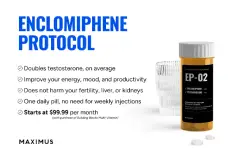madman
Super Moderator
MSACL 2025 Abstract
Matthew R Chappell (1), Meghan N Bradley (1), Matthew L Crawford (1), Sven Groesgen (2), Philippe Metz (2), Russell P Grant (1)
(1) Center for Esoteric Testing, Labcorp, Burlington NC 27215, (2) Roche Diagnostics GmbH, Mannheim, Germany
Abstract
INTRODUCTION
The measurement of estradiol (E2) is used to evaluate a variety of developmental and biological processes. Estradiol is one of the most potent steroid hormones, requiring sensitive and selective measurement down to <2 pg/mL (pediatrics, male patients, post-menopausal females). Increased levels of E2, up to 4000 pg/mL, are also assessed in conjunction with fertility evaluations to monitor ovulatory status and in preparation for in vitro fertilization. The wide dynamic range and improved analytical selectivity/sensitivity provided by LC-MS/MS is beneficial for both measurements of excess and diminished estradiol levels. Complex extraction procedures and 2D LC systems are challenges to scalability for clinical laboratories. The Roche Cobas® i 601 analyzer represents a fully integrated solution that offers parallel sample processing and LC-MS/MS analysis.
METHODS
The integrated, fully automated i 601 analyzer is designed as a sample-to-result solution mirroring clinical autoanalyzers that are ubiquitous in clinical diagnostic laboratories. The i 601 analyzer incorporates automated parallel sample processing (incubation with isotopically labeled E2 and pretreatment to release binding proteins) prior to antibody capture using paramagnetic particles. Following washing and elution, samples are partially evaporated on-board to concentrate extracts prior to liquid chromatography separation and analysis using an MRM mode triple quadrupole mass spectrometer. Chromatograms are automatically checked for peak quality prior to integration. Measurement results are calculated based on a leading calibration adjusted by an instrument-specific 2-point calibration. Estradiol was used to establish the performance characteristics of the i 601 analyzer.
RESULTS
Preliminary validation experiments have been conducted for the analysis of estradiol in serum samples. Following assay and instrument calibration, studies were performed over 28 days without recalibration. Imprecision was determined according to the CLSI EP5 guideline with two manufacturer quality controls and two serum matrix pools. Total variability based on 5 replicates per day over 5 days was 3.2%-4.6% CV (Coefficient of Variation). Intermediate precision based on 2 replicates, 2 times per day over 20 days was 3.3%-4.5% CV. Method comparison (45 samples, spanning the i 601analyzer measurement range), to the Labcorp CDC certified LLE with 2D-LC-MS/MS assay resulted in a Deming slope of 1.00, correlation coefficient of 0.998 and mean bias of 2.3%. Assay and instrument robustness testing, representing anticipated laboratory operation, was performed with 40 serum pools spanning the measurement range. Comparing results analyzed in batch mode (only assaying E2) versus random access testing (multiple assays in parallel) resulted in a Deming slope of 1.01, correlation coefficient of 0.99817 and a mean bias of 1.0%. Replacement of all reagent materials (lot-to-lot variability assessment) resulted in a Deming slope of 1.01, correlation coefficient of 0.99813 and a mean bias of -3.2%. Assessment of longitudinal 28-day calibration stability resulted in a Deming slope of 0.98, a correlation coefficient of 0.99848 and a mean bias of -1.4%. Assessment of elevated blood matrix interferences, such as hemolysis, lipemia and icterus, resulted in biases ranging from -1.3% to 3.1%. Matrix equivalency was performed using a 5-point admixing scheme using the high calibrator (3000 pg/mL) and 3 different serum pools, resulting in a mean recovery of 100.8%. A gravimetric spike and recovery experiment was performed at 3 different levels using 3 unique serum pools, resulting in a mean recovery of 103.3%. Recovery and imprecision results for samples spanning the ULMI (4000 pg/mL) were assessed using four serum pools gravimetrically prepared to within 80-120% of the ULMI. Samples >4000 pg/mL initially resulted as >Test and underwent automatic on-board dilution (1:4) prior to reanalysis. Results showed a mean recovery of 101.5%. Additional experimental data will follow in accordance with CLSI-C62.
CONCLUSIONS
Linearity, matrix equivalency, and recovery studies demonstrated excellent precision and accurate quantitation across the measurement range. Results from method comparison were highly correlated to a CDC-certified laboratory developed test (LDT). Robust stability of calibration over 28 days and multiple reagent packs was shown. Improved process efficiency streamlines complex extraction and analysis techniques, resulting in 25-fold improvement in workflow efficiency (tech time). The enhanced process efficiency of the i 601 analyzer delivers an innovative, integrated solution that simplifies the complexity of estradiol testing.
Matthew R Chappell (1), Meghan N Bradley (1), Matthew L Crawford (1), Sven Groesgen (2), Philippe Metz (2), Russell P Grant (1)
(1) Center for Esoteric Testing, Labcorp, Burlington NC 27215, (2) Roche Diagnostics GmbH, Mannheim, Germany
Abstract
INTRODUCTION
The measurement of estradiol (E2) is used to evaluate a variety of developmental and biological processes. Estradiol is one of the most potent steroid hormones, requiring sensitive and selective measurement down to <2 pg/mL (pediatrics, male patients, post-menopausal females). Increased levels of E2, up to 4000 pg/mL, are also assessed in conjunction with fertility evaluations to monitor ovulatory status and in preparation for in vitro fertilization. The wide dynamic range and improved analytical selectivity/sensitivity provided by LC-MS/MS is beneficial for both measurements of excess and diminished estradiol levels. Complex extraction procedures and 2D LC systems are challenges to scalability for clinical laboratories. The Roche Cobas® i 601 analyzer represents a fully integrated solution that offers parallel sample processing and LC-MS/MS analysis.
METHODS
The integrated, fully automated i 601 analyzer is designed as a sample-to-result solution mirroring clinical autoanalyzers that are ubiquitous in clinical diagnostic laboratories. The i 601 analyzer incorporates automated parallel sample processing (incubation with isotopically labeled E2 and pretreatment to release binding proteins) prior to antibody capture using paramagnetic particles. Following washing and elution, samples are partially evaporated on-board to concentrate extracts prior to liquid chromatography separation and analysis using an MRM mode triple quadrupole mass spectrometer. Chromatograms are automatically checked for peak quality prior to integration. Measurement results are calculated based on a leading calibration adjusted by an instrument-specific 2-point calibration. Estradiol was used to establish the performance characteristics of the i 601 analyzer.
RESULTS
Preliminary validation experiments have been conducted for the analysis of estradiol in serum samples. Following assay and instrument calibration, studies were performed over 28 days without recalibration. Imprecision was determined according to the CLSI EP5 guideline with two manufacturer quality controls and two serum matrix pools. Total variability based on 5 replicates per day over 5 days was 3.2%-4.6% CV (Coefficient of Variation). Intermediate precision based on 2 replicates, 2 times per day over 20 days was 3.3%-4.5% CV. Method comparison (45 samples, spanning the i 601analyzer measurement range), to the Labcorp CDC certified LLE with 2D-LC-MS/MS assay resulted in a Deming slope of 1.00, correlation coefficient of 0.998 and mean bias of 2.3%. Assay and instrument robustness testing, representing anticipated laboratory operation, was performed with 40 serum pools spanning the measurement range. Comparing results analyzed in batch mode (only assaying E2) versus random access testing (multiple assays in parallel) resulted in a Deming slope of 1.01, correlation coefficient of 0.99817 and a mean bias of 1.0%. Replacement of all reagent materials (lot-to-lot variability assessment) resulted in a Deming slope of 1.01, correlation coefficient of 0.99813 and a mean bias of -3.2%. Assessment of longitudinal 28-day calibration stability resulted in a Deming slope of 0.98, a correlation coefficient of 0.99848 and a mean bias of -1.4%. Assessment of elevated blood matrix interferences, such as hemolysis, lipemia and icterus, resulted in biases ranging from -1.3% to 3.1%. Matrix equivalency was performed using a 5-point admixing scheme using the high calibrator (3000 pg/mL) and 3 different serum pools, resulting in a mean recovery of 100.8%. A gravimetric spike and recovery experiment was performed at 3 different levels using 3 unique serum pools, resulting in a mean recovery of 103.3%. Recovery and imprecision results for samples spanning the ULMI (4000 pg/mL) were assessed using four serum pools gravimetrically prepared to within 80-120% of the ULMI. Samples >4000 pg/mL initially resulted as >Test and underwent automatic on-board dilution (1:4) prior to reanalysis. Results showed a mean recovery of 101.5%. Additional experimental data will follow in accordance with CLSI-C62.
CONCLUSIONS
Linearity, matrix equivalency, and recovery studies demonstrated excellent precision and accurate quantitation across the measurement range. Results from method comparison were highly correlated to a CDC-certified laboratory developed test (LDT). Robust stability of calibration over 28 days and multiple reagent packs was shown. Improved process efficiency streamlines complex extraction and analysis techniques, resulting in 25-fold improvement in workflow efficiency (tech time). The enhanced process efficiency of the i 601 analyzer delivers an innovative, integrated solution that simplifies the complexity of estradiol testing.












